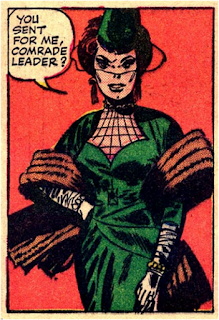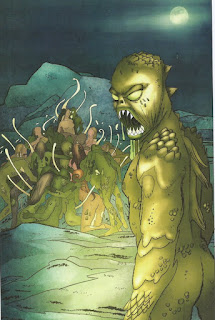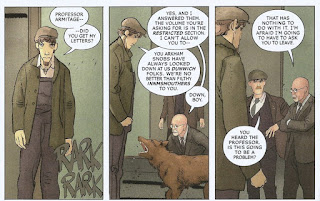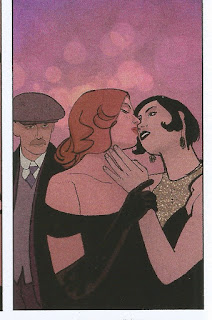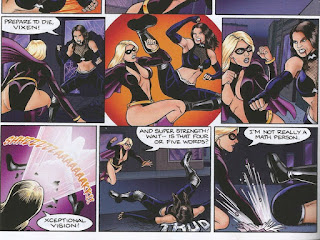Pick of the Brown Bag
February 24, 2021
by
Ray Tate
Welcome to the Pick of the Brown Bag. This week I look at the most recent Black Widow series from Kelly Thompson, Elena Casagrande and Jordie Bellaire. Five issues published. Five issues solid. If you're looking for a quicker judgement from my reviews, a teensy version of the POBB can be found on Twitter: #PickoftheBrownBag.
For those not in the know, Natasha Romanoff alias the Black Widow began life as a typical femme fatale. She didn't even wear a costume.
The KGB tasked her to kill Iron Man. Failing, she recruited an asset named Hawkeye for her cause. Two years later, Natasha reformed and became an Avenger soon after the bowman. Natasha never looked back. She officially defected from the Soviet Union, acquired American citizenship in Daredevil and joined SHIELD.
The Marvel Cinematic Universe retains Nat's Russian history, but pushes it forward. Nat for example spies on Iron Man for SHIELD, not the KGB, and becomes a founder of the Avengers, along with Hawkeye.
Most recently, the Soska Sisters dealt with Natasha's post traumatic stress over being killed by a Captain America doppelgänger. The Soskas' awesome rated R series involved child torture and murder. Nat didn't need to hold back, and sisters and brothers she didn't. Now, she feels even more like she's going through the motions. She needs motivation. She needs a change. She needs...
Huh. Well, that's unexpected. Suddenly, Black Widow is an architect/civil engineer in a beautifully composed illustration by Elena Casagrande.
Of course it doesn't actually happen that way. Suddenly that is. The premiere issue begins in Black Widow rote.
The good guys task Black Widow for a mission, and Casagrande and the Widow promptly scythe through a bunch of goons. Though no wet-work. A promise is a promise, after all. A short reunion with Captain America quickly leads to this curious scene.
Okay. Look, this isn't your first rodeo.
You're thinking, and rightfully so, virtual reality. Nat is sporting headphones and goggles in a closet somewhere, living a false life she may actually want but can never have.
Except it's not that simple.
Natasha's life as an architect is actually unfolding in the context of Marvel reality. Read on, MacDuff, and you'll discover she's been missing for three months.
Normally, when a person disappears for three months, it's a cold case. Thompson though sagely points out that Natasha likes to vanish. Indeed, Black Widow's history is filled with gaps in which she ducks out of the superhero and spy business. Very rarely if at all is she killed or trapped in another dimension. Usually, she's vacationing in Europe.
Thompson is known for infusing humor into her work, and Black Widow is no different. Make no mistake, this is a drama, but it's got Hawkeye and Bucky among the guest cast. So, you can expect an aspect of buddy-cop comedy.
Bucky works way, better in the Marvel Cinematic Universe because first and foremost Sebastian Stan...
...and second, he hasn't been out of Captain America's sight for all that long.
In the comic books, a historical forty year gulf divides Bucky's purported death and the recreation of Bucky as the Winter Soldier. Bucky's been dead for that long. So, readers have been ingrained with Cap waking up from whenever being knocked out with his cheery shout of "Bucky! Noooooo!" for that long.
Winter Soldier was a big deal when Ed Brubaker and Steve Epting introduced him back in 2005. Only recently, and I believe because of the MCU, can writers now poke some fun at the Winter Soldier/Bucky dichotomy.
In Black Widow, like the Punisher, Hawkeye doesn't take Bucky seriously as the Winter Soldier. You get the impression that he would respect him more as Bucky Barnes, Cap's sidekick.
Hawkeye approaches Nat under the pretense of admiring her new bike purchase. The bike a souped up black model with red piping symbolizes the Black Widow still lies beneath the surface, but she is completely oblivious to Hawkeye's identity.
It gets even weirder than Natalie, architect and civil engineer.
Now, I know what you're thinking, and you're wrong. Virtual reality is wrong. What you're thinking is wrong. Thompson gives the reader problems to solve that involve real world math. How can Natalie possibly have a child in three months if not already pregnant the last time we saw her in issue one?
At this point you may be musing that perhaps Natalie is a clone of the Black Widow. In the Marvel Universe it's not too far-fetched. Through hocus-pocus Black Widow exists in a cloned body of the original the Captain America doppelgänger slew. So perhaps Natalie isn't the Black Widow.
That would be a no then.
Throughout the three issues, Thompson drops clues to the masterminds behind the plot. The hired help she reveals at the end of issue one, but the puppet master stays hidden until this third issue. The involvement certainly makes sense. I just wish that the Black Widow had a better rogue's gallery to choose from. Fact is. Because Widow is a spy and superhero, few of her enemies survive her. She's not averse to ending them. Hence, Captain America requesting her not to perform any wet-work in the debut. One of her surviving enemies became an ally, and she also appears in the series.
The White Widow is Yelena Belova. Devin Grayson and J.G. Jones introduced her back in the nineties in an issue of The Inhumans. This is less curious than you think since Black Widow and the Inhumans shared Amazing Adventures. Most however encountered Yelena in Black Widow: Itsy-Bitsy Spider, as Natasha's enemy. An upstart who intended to take her place on behalf of the Soviet Union.
Fortunately, Yelena really didn't do any lasting damage, and her fervent faith in the U.S.S.R. crumbled with the regime change. Richard K. Morgan and Bill Sienkiewicz reclaimed Yelena for the side of dark angels in their Black Widow mini-series: The Things They Say About Her. This eventually led to an uneasy friendship with Natasha. All these mini-series by the way are highly recommended.
Thompson's story is fairly original. The closest I can come to finding a germ of her idea is in an episode of Alfred Hitchcock Presents. Even that however isn't exact. If the story doesn't float your boat, Elena Casagrande's and Jordie Bellaire's artwork will. Despite being in domestic bliss and a young mom, Black Widow strikes numerous foes in an animated style given widescreen scope. In issue five we also get a good showing from her allies.
